Fan speed controller: types of device and connection rules
A fan is one of the unnoticeable but extremely important devices that help create favorable conditions for work, relaxation and simply having a good time.
Without it, computers, refrigerators, air conditioners and other equipment will not be able to function. To ensure the most efficient operation of various devices, use a fan speed controller.
From our material you will learn about what types of regulators there are and the features of their operation. We will also tell you how to assemble the device yourself and what you will need for this.
The content of the article:
Types and features of the device
There are many types of fans, they are involved in the operation of climate control systems, computers, laptops, refrigerators, and many other office and household appliances.
To control the speed of rotation of its blades, a small element is often used - a regulator. It is this that allows you to extend the life of the equipment, as well as significantly reduce the noise level in the room.
Purpose of the device for speed control
When an air conditioner or fan constantly operates at the maximum power provided by the manufacturer, this adversely affects its service life. Some parts simply cannot withstand such a rhythm and quickly break.
Therefore, you can often find recommendations to make a power reserve when choosing various types of equipment so that it does not work at the limit.
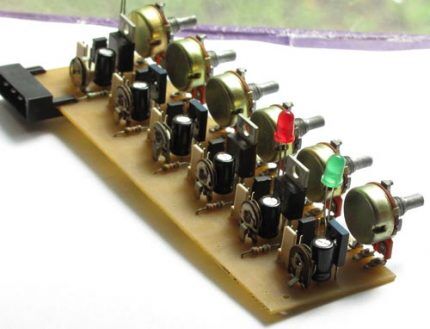
Also, often in refrigeration units, computers and other equipment, certain elements overheat during operation. To prevent them from melting, the manufacturer has provided for their cooling by operating fans.
But not all tasks performed require maximum fan/cooler speed.When working on a computer in an office environment or maintaining a constant temperature in a refrigeration unit, the load is significantly less than when performing complex mathematical calculations or freezing, respectively. A fan that does not have a regulator will rotate at the same speed.
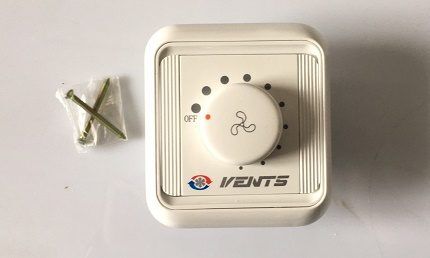
The accumulation of a large number of powerful equipment operating in one room can create noise at a level of 50 decibels or more due to simultaneously operating fans at maximum speed.
It is difficult for a person to work in such an atmosphere; he gets tired quickly. Therefore, it is advisable to use devices that can reduce the fan noise level not only in production workshops, but also in office premises.
In addition to overheating individual parts and reducing noise levels, regulators allow rational use of equipment, reducing and increasing, if necessary, the speed of rotation of the equipment blades. For example, in climate control systems used in many public places and industrial premises.
One of the important details of smart ceiling ventilation devices rooms are speed regulators. Their operation is ensured by indicators of temperature, humidity, and pressure sensors. Fans used to mix the air in a gym, production workshop or office room help save money spent on heating.
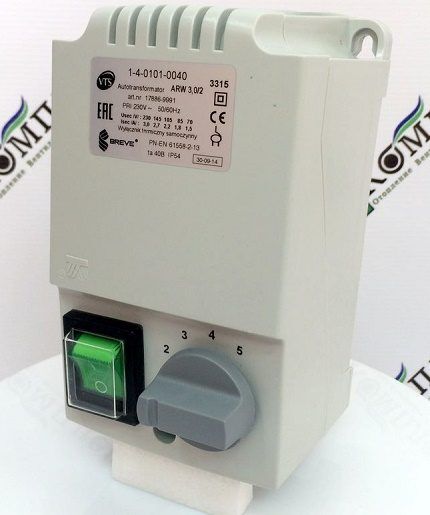
This occurs due to the uniform distribution of heated air circulating in the room. Fans force the upper warm layers down, mixing them with the cooler lower layers. After all, for human comfort it is important that there is warmth in the lower part of the room, and not near the ceiling. Regulators in such systems monitor the speed of rotation, slowing down and accelerating the speed of the blades.
Main types of regulators
Fan speed controllers are in demand. The market is replete with various offers and the average user who is not familiar with the features of devices can easily get lost among the various offers.
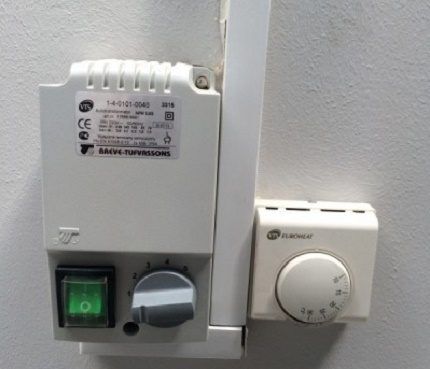
Regulators differ in their operating principle.
The following types of devices are distinguished:
- thyristor;
- triac;
- frequency;
- transformer
First type devices is used to adjust the speed of single-phase devices that have overheating protection. The speed change occurs due to the influence of the regulator on the power of the supplied voltage.
Second type is a type of thyristor device. The regulator can simultaneously control DC and AC devices. Characterized by the ability to smoothly decrease/increase the speed of rotation at a fan voltage of up to 220 V.
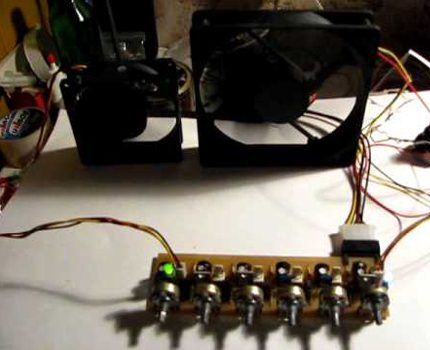
Third type devices changes the frequency of the supplied voltage. The main task is to obtain a supply voltage in the range of 0-480 V. The controllers are used for three-phase equipment in room ventilation systems and in powerful air conditioners.
Transformer controllers can operate with single- and three-phase current. They change the output voltage, regulating the fan and protecting the device from overheating. They can be used in automatic mode to regulate the speed of several powerful fans, taking into account the readings of pressure, temperature, humidity and other sensors.
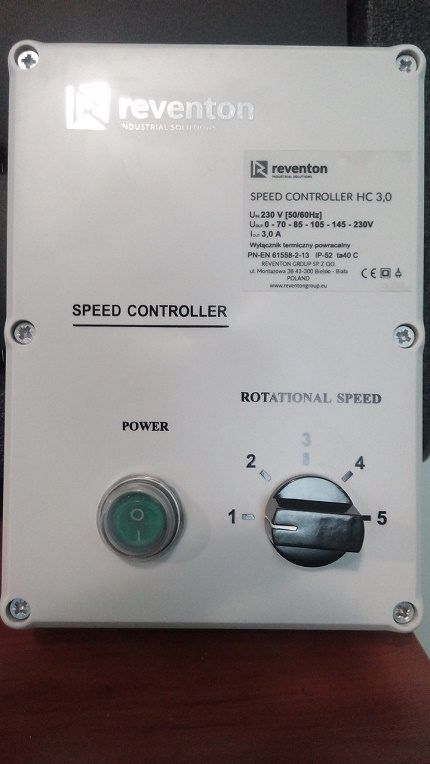
Most often, triac regulators are used in everyday life. They are classified as XGE type. You can find many offers from different manufacturers - they are compact and reliable. Moreover, the price range will also be very wide.
Transformer devices are quite expensive - depending on additional features, they can cost $700 or more. They belong to the RGE type regulators and are capable of regulating the speed of very powerful fans used in industry.
Features of using devices
Fan speed controllers are used in industrial equipment, offices, gyms, cafes, and other public places. You can also often find such controllers in climate control systems for home use.
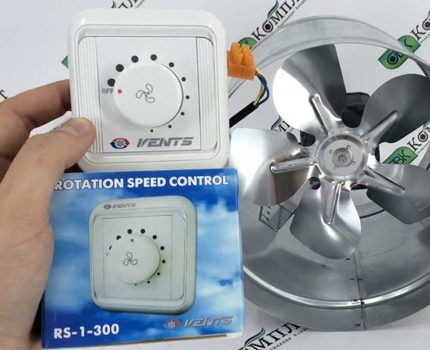
Ventilation systems used in fitness centers, as well as air conditioners switched on for heating in office premises, they most often contain a rotation speed regulator. Moreover, this is not a simple cheap option, but an expensive transformer device capable of regulating the rotation speed of powerful devices.
Depending on the design features, controllers are:
- mechanical control;
- automatic.
Autotransformer regulators are most often used in complex systems, where the command to action is provided by indicators obtained from a temperature, pressure, motion, humidity or photosensor. By slowing down the rotation speed, the devices reduce energy consumption.

Mechanical control of the controllers is carried out manually - the device contains a wheel that allows you to smoothly or stepwise change the rotation speed. This can often be found in triac models.
Among the regulators used to optimize the operation of industrial and household equipment, one can note such devices as Vents, SeBeP, Vortice, EnergySaver, Delta t°, Telenordik and others.
The most common option for using control equipment in a domestic environment is a computer and laptop.This is where the regulator is most often used, controlling and changing the speed of the cooler. Due to this device, the equipment creates significantly less noise during operation.
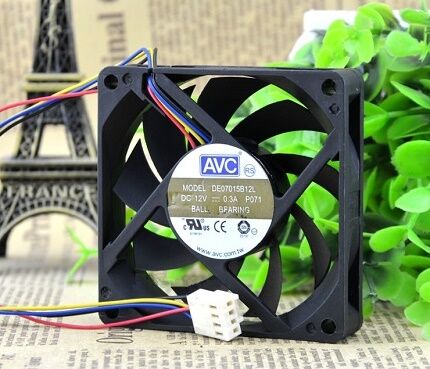
Cooler controllers come in both simple and with additional capabilities. These can be models with backlight, with a temperature sensor, with an alert signal, with an emergency shutdown, etc.
Based on their appearance, there are regulators with and without display. The first option is more expensive, and the second is cheaper. This device is often called a reobass.
Manufacturers offer models that control the operation of one or more fans. Cooler speed controllers from companies such as Scythe, NZXT, Reeven, AeroCool, Aqua Computer, Strike-X Advance Black, Akasa Fan Controller, Cooler Master, Innovatek, Gelid, Lian Li, etc. have good reviews.
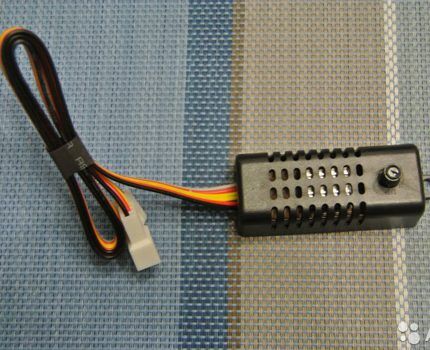
Using a controller in computer operation significantly reduces the noise level, which has a positive effect on the user’s well-being and mood - nothing buzzes or roars. Also, which is very important, it helps to avoid overheating of the equipment itself, thereby extending its service life.
Controller connection rules
To connect the fan speed controller, you can use the services of specialists or try to do it yourself. There are no fundamental features in connection - it is quite possible to cope with such a task on your own.
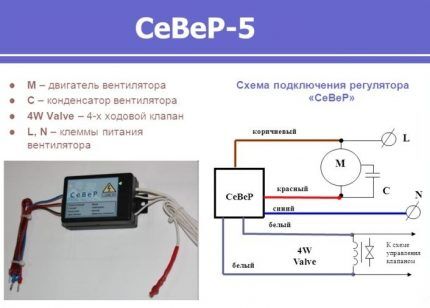
Depending on the design features and type of equipment being serviced, controllers can be installed:
- on the wall as an overhead socket;
- inside the wall;
- inside the equipment housing;
- in a special cabinet that controls smart devices at home. This is usually a terminal block;
- connect to the computer.
To connect the regulator yourself, you must first carefully read the instructions provided by the manufacturer. Such a document usually comes with the device and contains useful recommendations for both connection, use and maintenance.
Wall-mounted and in-wall models must be secured to the wall with screws and dowels. Components are most often supplied by the manufacturer along with the main device. Also in the instructions for the regulator you can see a diagram of its connection. This will greatly facilitate further work on its correct installation.
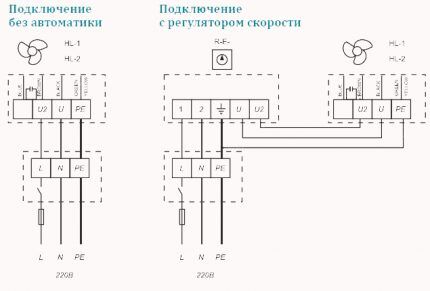
The speed controller is connected to the cable supplying the fan, according to the manufacturer's diagram. The main goal is to cut the phase, neutral and ground wires and connect the wires to the input and output terminal blocks, following the recommendations. In the case where the fan has its own separate switch, it will have to be replaced with a regulator, dismantling the first one as it is unnecessary.
Don't forget that cross-section of the supply and connecting cables must correspond to the maximum voltage current of the connected device.
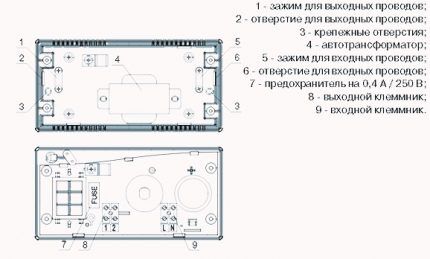
If you are going to connect the controller to a PC, then you first need to find out what the maximum permissible temperature of the individual components of the equipment is. Otherwise, you can permanently lose your computer, whose important parts will overheat and burn out - the processor, motherboard, graphics card and others.
The model of the selected reobass also has instructions and connection recommendations from the manufacturer. It is important to adhere to the diagrams given on its pages when installing the device yourself.
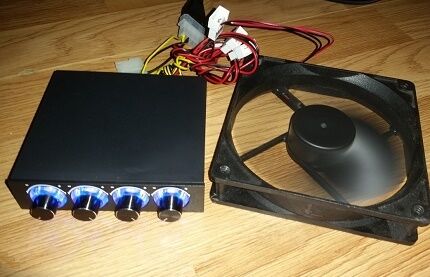
There are regulators and devices built into the housing that are purchased separately. To connect them correctly, you should follow the instructions.
For example, an integrated controller has on/off buttons on the outside of the system unit. The wires coming from the regulator are connected to the cooler wires. Depending on the model, the rheobass can control the speed of 2, 4 or more fans in parallel.
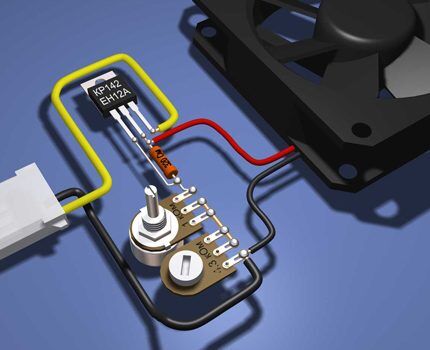
A separate regulator for the cooler is installed in a 3.5 or 5.25-inch bay. Its wires are also connected to coolers, and additional sensors, if included, are attached to the corresponding components of the system unit, the condition of which they will monitor.
Assembling the device yourself
You can assemble the fan speed controller yourself. To do this you will need the simplest components, a soldering iron and some free time.
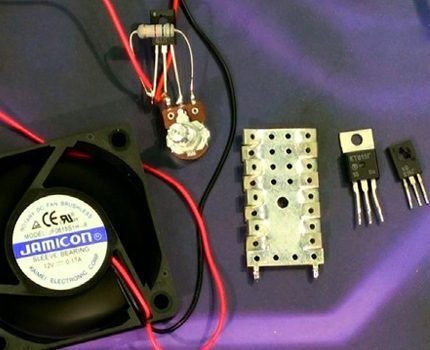
So, to make a simple controller you need to take:
- resistor;
- variable resistor;
- transistor.
The base of the transistor must be soldered to the central contact of the variable resistor, and the collector to its extreme terminal. To the other edge of the variable resistor you need to solder a resistor with a resistance of 1 kOhm. The second terminal of the resistor should be soldered to the emitter of the transistor.

Now all that remains is to solder the input voltage wire to the collector of the transistor, which is already connected to the extreme terminal of the variable resistor, and the “positive” output to its emitter.
To test your homemade product in action, you will need any working fan. To evaluate a homemade reobass, you will need to connect the wire coming from the emitter to the fan wire with the “+” sign. The homemade output voltage wire coming from the collector is connected to the power supply.
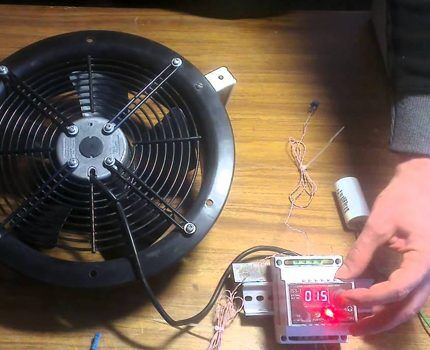
The wire with the “–” sign is connected directly, bypassing the homemade regulator. Now all that remains is to check the operation of the soldered device.
To decrease/increase the speed of rotation of the cooler blades, you need to turn the variable resistor wheel and observe the change in the number of revolutions.
This homemade device is safe to use, because the wire with the “–” sign goes straight. Therefore, the fan is not afraid if something suddenly shorts in the soldered regulator.
Such a controller can be used to regulate cooler speed, exhaust fan and others.
Conclusions and useful video on the topic
Video about the features of connecting and using a fan speed controller from the Vents company:
Detailed video about the types of regulators, principles of their operation and connection features:
Video instructions with explanations of each step when performing work on assembling the cooler speed controller with your own hands. Moreover, to perform these actions you do not need to be a specialist - everything is quite simple:
Video information on creating a fan speed controller:
Review of electronic autotransformer fan speed controller:
After familiarizing yourself with the types of fan speed controllers and the rules for connecting them, you can choose the most optimal option that can satisfy the user’s needs. If you wish, you can entrust installation issues to specialists. If you want to test your strength, then a simple device is easy to assemble yourself.
Do you have any questions about the topic of the article, have you found any shortcomings, or do you have information that you want to share with our readers? Please leave comments at the bottom of the article.
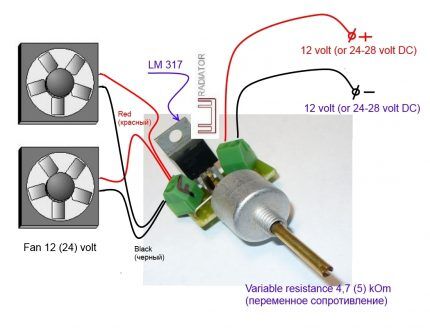




A very good article, it is clear that the author loves his work and spent a lot of time on the article, content, and design. Thank you.
I had a chance to deal with Vents speed controllers RS-1-300. In terms of price, they are quite inexpensive, especially considering their European counterparts. For household use this is the most suitable option. Naturally, not everyone can figure out how to connect it correctly, given that there are now more humanists than techies.
I've never heard of a laptop fan controller before. I would love to purchase this useful device. At night, this monster works like a refrigerator. It is possible to work silently at night, and at the same time the laptop will not actually burn out and will not turn off in order to cool down in the most interesting place. One question concerns me: how can I understand the devices myself, which one should I choose? Who can help?
Katerina, I read your review, maybe it’s too late to talk about it now, but such a scheme for adjusting fan speed on a laptop is not recommended. And there is even little chance of hiding its components in the laptop case. The fact is that every laptop already has a built-in speed controller. The problem with increasing speed may be due to the fact that over time the laptop radiator fills with dust. Thermal paste also dries out on the processor, which will cause it to heat up and increase speed, even when just reading text, for example... but maybe also load the process.
As Vadim already wrote, such a device cannot be implemented for a laptop cooler. The rotation speed of the fan on the laptop cooler is adjusted automatically by the operating system itself and the drivers. Typically, speed controllers are installed in desktop computers (but even there it is safer to give this work to the OS than to adjust it manually).
If you have problems with your laptop overheating, this indicates that you need to clean the laptop from dust and replace the thermal paste. This is a fairly common occurrence; many people don’t even know that their laptop needs to be cleaned once a year, at least.I recommend that you take your laptop to a service center if you have never done this yourself, and as a temporary solution I can recommend purchasing a cooling pad.
Hello. I have a regular “under-the-book” cooler with backlight, powered by USB. It makes virtually no noise, plows a lot and often. Cost 300 rubles. For a laptop, finding cooling is not a problem; again, the store can show you its noise level before checking it.
Thank you very much to the author, very informative!